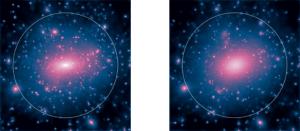Blog
Maximum Entropy
30 October 2020
 Brinckmann et al.
Brinckmann et al.It now seems clear that dark matter interacts more than just gravitationally. Earlier studies1 have hinted at this, and a new study supports the idea even further.2 What’s interesting about this latest work is that it studies dark matter interactions through entropy.
Entropy is a subtle and powerful concept in physics. It was first introduced as a property in thermodynamics, but it plays a role in everything from black holes to the flow of time. It’s also rather difficult to define without relying on mathematics.
 Brian Koberlein
Brian KoberleinEntropy is often described as a measure of the disorder of a system. Ice, for example, with its water molecules arranged into symmetrical crystals has lower entropy than water, with its chaotic dance of water molecules. Since warmer things tend to be more disordered, entropy is also related to the temperature of an object. Hence, the second law of thermodynamics states that the entropy of a system can’t decrease, which also means that heat flows from warm objects to cold ones.
For this latest work, entropy is better described in terms of how likely an object is to be in a particular state. Imagine lighting a scented candle in the corner of a room. While it is statistically possible for the scent of the candle to hover around the candle, the motion of the air in the room will most likely spread the scent throughout the room. An evenly spread scent is the most likely outcome because it is the state with the maximum entropy. It’s a state also known as thermodynamic equilibrium.
 Brian Koberlein
Brian KoberleinIn this new study, the team used computer models to calculate the state of maximum entropy for dark matter in dwarf galaxies. The distribution of dark matter determines how strongly light will gravitationally lens. When the team looked at theoretical lensing by galactic dark matter in maximum entropy, they found it agreed with observed lensing around dwarf galaxies. Thus, dark matter seems to be in a state of maximum entropy.
This means dark matter must interact in some way. The scent in a room reaches maximum entropy because the aroma molecules interact strongly with molecules of air. All those interactions work to increase the entropy of the room. Dark matter doesn’t interact strongly with regular matter, so this study suggests it strongly interacts with itself.
Without knowing exactly what dark matter is, we don’t know how it can interact. But this study and others further confirm the reality of dark matter.
Brinckmann, Thejs, et al. “The structure and assembly history of cluster-sized haloes in self-interacting dark matter.” Monthly Notices of the Royal Astronomical Society 474.1 (2018): 746-759. ↩︎
Almeida, Jorge Sánchez, Ignacio Trujillo, and Angel Ricardo Plastino. “The principle of maximum entropy explains the cores observed in the mass distribution of dwarf galaxies.” Astronomy & Astrophysics 642 (2020): L14. ↩︎